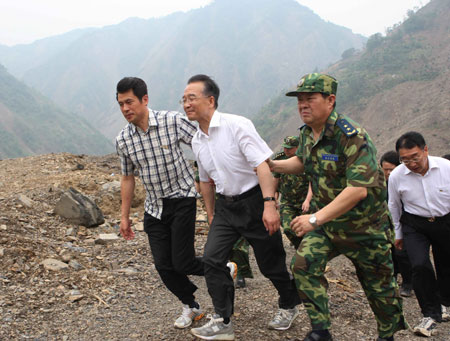Quake lake water flows downstream
By Zhang Haizhou and Hu Yinan (China Daily)
Updated: 2008-06-07 08:44
Updated: 2008-06-07 08:44
MIANYANG, Sichuan -- Water finally passed the overflowing point of a major quake lake's dam early on Saturday morning amid heavy rain. But the overspill's impact on the dam and hundreds of thousands of people downstream remains to be seen.
Tangjiashan lake is the largest of the more than 30 quake lakes formed when the May 12 earthquake triggered landslides that choked rivers.
Water banked up behind the natural mud-and-rock dam edged past a sluice built by troops in recent days at 0:45 am, Xinhua New Agency reported, which meant a partial discharge of floodwaters finally started after days of waiting.
|
|
However, the locals still showed the typical optimism of the Sichuanese in the face of the possible danger of a bursting lake.
Liu Ganghu, a grocer in Qingyi, a town about 50 km from Tangjiashan, was watching TV with his family in his shop on Friday night. His 96-year-old grandma was already asleep.
"We've been worrying so much for so long, and we've got used to it," said the 30-year-old, stripped to his waist because of the hot weather. He said they didn't join the 250,000 evacuees because the local authorities said the lake water would not flood his home even if one-third of the dam collapsed.
But he said he would keep his grocery door open all night in case of any emergency. A van was waiting by the door, and on the wall hung a red sign showing the escape route.
"We've been told that whenever alarm sounds, we must follow the route to go up nearby hills. The whole process takes only a few minutes by driving," he said.
Traffic thinned out in Mianyang, a major city downstream, on Friday night, but there were no signs of panic among locals.
People living along the east bank of the city's Fujiang River, which will be flooded if the lake bursts its bank, had been evacuated. Those on the higher west bank stayed, but were told to remain alert.
A bridge of the Baoji-Chengdu railway, which crosses the Fujiang River, has been reinforced. Each pier was surrounded by dozens of tires fastened by steel bars to prevent it from being hit by objects in the floodwater.
The height, not the physical toughness, of the riverbank, is the real concern, said Ding Ji'an, general manager of the Mianyang Architectural Design Institute.
Fucheng, the city's central business district, lies on the west side of the Fujiang River, while Youxian, a mainly residential district, lies on the east.
The riverbank is more than 10 m high on the Fucheng side. But only about 6 m high on the Youxian side, Ding said.
|
||
|
||
|
|
|
|
